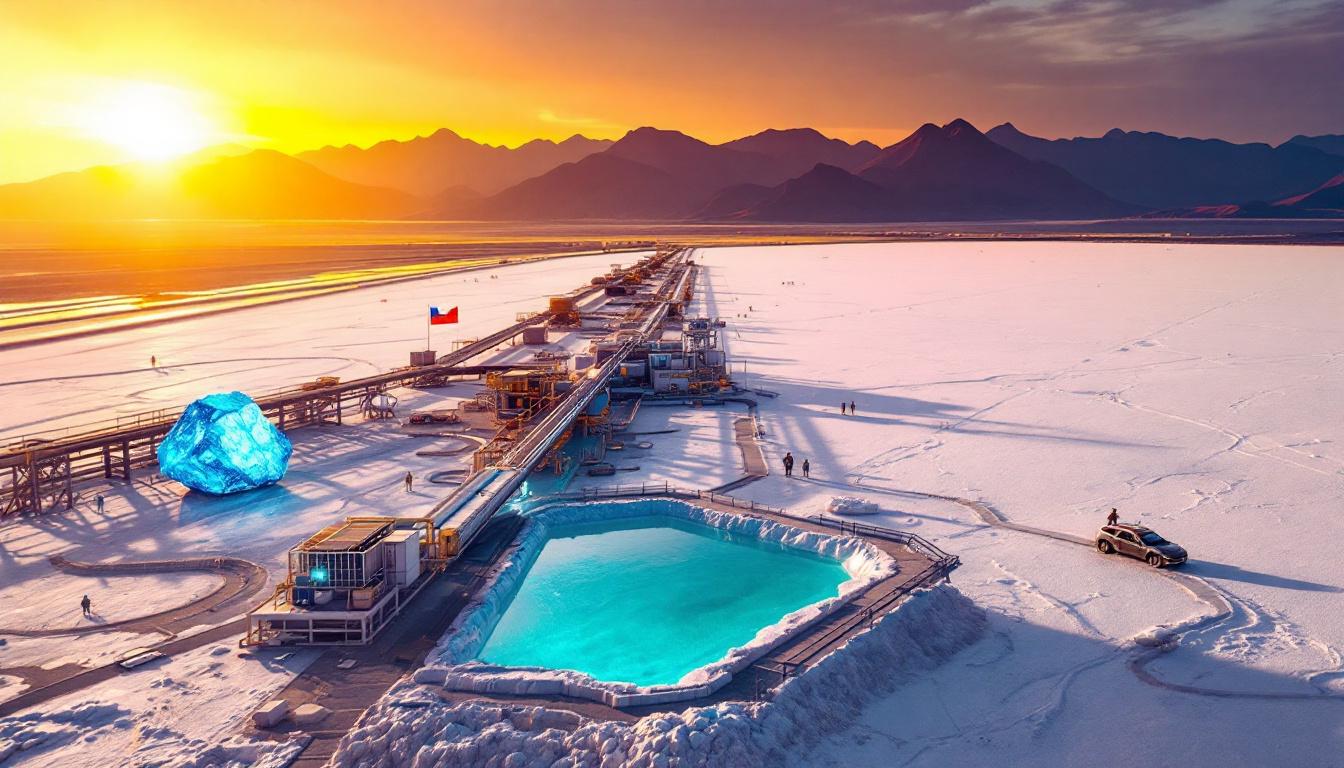## Why Is Terbium Following Gallium's Price Surge?
Terbium demand and china export restrictions are contributing to dramatic price movements in 2024. Terbium prices have surged by 32% since January 2024. Its rising value mirrors gallium’s previous price explosion. Consequently, defence and technology sectors now rely more heavily on scarce materials.
Industry analysts observe that the surge stems primarily from supply-chain disruptions. China's control of approximately 85% of global production intensifies these effects. For instance, a chinese export restrictions update discusses similar measures impacting related materials.
Dr. James Henderson, a metals strategist, noted that the market is facing a perfect storm of supply restrictions and escalating demand. Comparisons with gallium are inevitable. However, terbium is even scarcer, creating increased price volatility.
## What Is Driving China's Rare Earth Export Restrictions?
China’s strategy relies on export controls linked to national security. In addition, the country seeks to capture more value by processing raw materials domestically. These policies encourage technological advancements and add economic weight to China’s geopolitical leverage.
Furthermore, export restrictions serve as a strategic tool amid ongoing trade tensions with Western nations. For example, expanding defence collaborations in the Indo-Pacific region further complicates supply chains. Internal documents reveal that these restrictions are part of a comprehensive strategic materials security approach.
Environmental concerns also play a role. China’s stricter controls aim to reduce harmful mining practices prevalent in regions such as Inner Mongolia and Jiangxi Province. Consequently, these measures have reshaped the global market dynamics for rare earth elements.
## How Rare Is Terbium Compared to Other Rare Earth Elements?
Terbium is one of the rarest of the rare earth elements. With a crustal abundance of roughly 1.2 parts per million, its scarcity is striking when compared to neodymium (38 ppm) or cerium (68 ppm). This inherent rarity underscores its strategic importance.
In nature, terbium is not found freely. It usually occurs in complexes like monazite and xenotime, or in ion-adsorption clays. The challenge is further compounded by low ore concentrations, often below 0.1%. Consequently, processing becomes resource-intensive and technically challenging.
Notably, the extraction of terbium requires advanced techniques. In addition, careful separation from similar rare earth elements is necessary. A recent scientific study details breakthrough extraction methods that could reshape the industry.
## What Are the Key Applications of Terbium in Defence and Technology?
Terbium’s exceptional magnetostrictive properties make it indispensable in defence applications. For instance, terbium-iron-dysprosium alloys serve essential roles in sonar systems, precision-guided munitions, and advanced radar technologies. Consequently, the material is classified as a Tier 1 Critical Material by the US Department of Defence.
Commercial usage is equally important. Terbium is used in solid-state devices and high-efficiency lighting through terbium-doped compounds. It also plays a part in advanced medical imaging and quantum computing research. In addition, the element’s role in optical isolators aids next-generation fibre optic communications.
Terbium’s importance is evident in its diverse applications, including:
– Guidance systems for hypersonic missiles
– Night vision and thermal imaging devices
– Electronic countermeasure systems
– Advanced radar systems
– Satellite communications equipment
Such applications underscore the considerable industrial reliance on terbium.
## How Large Is the Global Terbium Market and What Is Its Growth Trajectory?
Market projections for the global terbium sector are strong. Valued at approximately US$7.8 billion in 2023, forecasts predict an increase to about US$27.6 billion by 2031. This growth is driven by increasing industrial and defence demands.
Worldwide production of terbium oxide is currently around 400–450 metric tons. However, demand is expected to rise to nearly 700 metric tons by 2028. Consequently, this widening supply-demand gap is pushing prices further upward, with some forecasts suggesting values near US$2,000 per kilogram by 2026.
Key drivers underpinning this trend include:
1. Renewable energy transitions, particularly in wind power
2. Electric vehicle proliferation
3. Increased defence spending by NATO and Asia-Pacific nations
4. Expansion of 5G infrastructure into future 6G
Each of these factors reinforces the critical nature of terbium in the modern industrial landscape.
## Which Countries Currently Mine Terbium Outside of China?
While China remains the dominant producer, several countries are emerging as alternative suppliers. Australia, for instance, is rapidly developing its rare earth resources. The Browns Range project in Western Australia is a notable initiative. For more regional insights, consider the boost to iluka's rare earth refinery.
The United States is also reinvigorating its production capabilities. At the Mountain Pass mine in California, efforts to recover rare earths are underway. Additional projects in Canada and Greenland further highlight the global interest in diversifying supply chains.
Other notable producers and upcoming projects include:
– Myanmar: Produces significant quantities despite environmental challenges
– Malaysia: Hosts processing facilities that export to international markets
– Vietnam and Brazil: Developing deposits with foreign technical assistance
– India: Intensifying efforts at the Chavara deposit in Kerala
Such diversification efforts are critical given the ongoing terbium demand and china export restrictions influencing market stability.
## How Is Australia Positioned in the Global Terbium Supply Chain?
Australia is quickly emerging as a strong alternative to Chinese supplies. Its reserves account for roughly 4% of global rare earth resources. In addition, the country benefits from diverse deposit types that often yield higher concentrations of heavy rare earths like terbium.
Local projects such as the cefc invests $75 million in critical minerals support this growth. The Australian government has implemented significant policy supports, including a US$2 billion Critical Minerals Facility. Furthermore, partnerships with the US, Japan, and the EU offer additional assurances.
Australian miners adhere to strict environmental and social governance standards. Therefore, developments in projects like the Browns Range and Dubbo projects present promising alternatives to Chinese supplies.
## What New Extraction Technologies Are Being Developed for Terbium?
Recent innovations are set to revolutionise terbium extraction. Traditional methods have been environmentally challenging, prompting investments in breakthrough technologies. These modern techniques aim to reduce chemical usage and boost recovery rates significantly.
One breakthrough is the advanced solvent extraction technique developed by Australian Strategic Materials. This method reduces chemical consumption by 30% while increasing yield. In addition, ionic liquids are emerging as a safer alternative, achieving separation factors notably higher than conventional methods.
Other promising approaches include bioleaching and membrane separation technologies. – Bioleaching: Utilises bacteria and fungi to extract terbium
– Membrane separation: Uses nanofiltration for more efficient processing
– Direct electrochemical extraction: Explores electrical methods for separation
For investors seeking practical insights, a beginner’s guide to investing in mining stocks offers a useful perspective on the underlying technologies.
## Which ASX-Listed Companies Are Developing Terbium Projects?
Several ASX-listed companies provide exposure to the evolving terbium market. Northern Minerals leads with its Browns Range project in Western Australia. The company reported promising initial outputs. In addition, its pilot plant processes xenotime ore with notable terbium content.
Australian Strategic Materials is advancing its Dubbo project in New South Wales. This polymetallic initiative not only leverages rare earths but also benefits from downstream processing capabilities. For investors looking for detailed assessments, navigating mining investments and geological insights is particularly insightful.
Other companies include Victory Metals, Arafura Rare Earths, Hastings Technology Metals, and Lynas Rare Earths. For example, Victory Metals explores clay-hosted deposits that resemble Chinese ion-adsorption clays. In addition, these companies have varying degrees of exposure to terbium.
## What Are the Strategic Implications of China's Terbium Export Controls?
China’s export controls have far-reaching strategic effects on global supply chains and national security. Terbium demand and china export restrictions place Western defence systems under pressure. Policy experts warn that alternative supply chains must be established swiftly.
In defence applications, delays in securing terbium can affect critical programmes. For instance, naval sonar systems and precision-guided munitions are at risk. Moreover, these restrictions contribute to broader geopolitical tensions, further elevating market uncertainty.
In summary, the market for terbium is shaped by technological needs, geopolitical strategies, and innovative extractions. The primary keyword, terbium demand and china export restrictions, appears repeatedly to underscore these trends. Current developments suggest that shifting supply chains and strategic policy reforms are set to redefine the global rare earth landscape.
Looking for Early Alerts on Critical Mineral Discoveries?
Stay ahead of the market with Discovery Alert's proprietary Discovery IQ model, delivering real-time notifications when significant rare earth discoveries like terbium are announced on the ASX. Explore how major mineral discoveries can lead to exceptional returns by visiting the Discovery Alert discoveries page and position yourself to capitalise on the next opportunity before mainstream investors.




